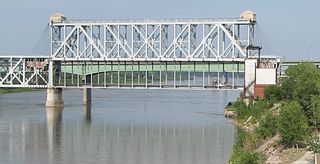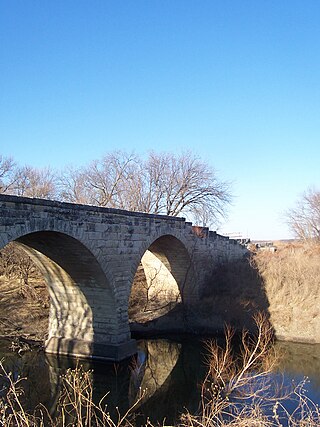
BNSF Railway is the largest freight railroad in the United States. One of six North American Class I railroads, BNSF has 36,000 employees, 33,400 miles (53,800 km) of track in 28 states, and over 8,000 locomotives. It has three transcontinental routes that provide rail connections between the western and eastern United States. BNSF trains traveled over 169 million miles in 2010, more than any other North American railroad.

The Southwest Chief is a long-distance passenger train operated by Amtrak on a 2,265-mile (3,645 km) route between Chicago and Los Angeles through the Midwest and Southwest via Kansas City, Albuquerque, and Flagstaff mostly on the BNSF's Southern Transcon, but branches off between Albuquerque and Kansas City via the Topeka, La Junta, Raton, and Glorieta Subdivision. Amtrak bills the route as one of its most scenic, with views of the Painted Desert and the Red Cliffs of Sedona, as well as the plains of Illinois, Missouri, Kansas, and Colorado.

Montana Rail Link was a privately held Class II railroad in the United States. It operated on trackage originally built by the Northern Pacific Railway and leased from its successor BNSF Railway. MRL was a unit of The Washington Companies and was headquartered in Missoula, Montana.

The Kiamichi Railroad Company is a Class III short-line railroad headquartered in Hugo, Oklahoma.

The Quincy Rail Bridge is a truss bridge that carries a rail line across the Mississippi River between West Quincy, Missouri, and Quincy, Illinois, USA. It was originally constructed in 1868 for the Chicago, Burlington and Quincy Railroad, a predecessor of BNSF Railway.

The Hannibal and St. Joseph Railroad was the first railroad to cross Missouri starting in Hannibal in the northeast and going to St. Joseph, Missouri, in the northwest. It is said to have carried the first letter to the Pony Express on April 3, 1860, from a train pulled behind the locomotive Missouri.

The Armour-Swift-Burlington (ASB) Bridge, also known as the North Kansas City Bridge and the LRC Bridge, is a rail crossing over the Missouri River in Kansas City, Missouri, that formerly also had an upper deck for automobile traffic.
The 18th Street Expressway is a freeway in Kansas City, Kansas that runs from Interstate 35 north to Interstate 70/U.S. Route 24/U.S. Route 40. It carries the U.S. Route 69 designation its entire length.

South Kansas and Oklahoma Railroad is a short line railroad which operates 730.34 miles (1,175.37 km) of rail lines in Kansas, Oklahoma and Missouri that used to belong to Missouri Pacific, Frisco and Santa Fe lines. SKOL is a unit of Watco.

K-177 is a 102.871-mile-long (165.555 km) south–north state highway in central Kansas. It runs from U.S. Route 54 (US-54) near El Dorado northward to US-24 in Manhattan, passing through the Flint Hills. It is part of the Flint Hills Scenic Byway and the Prairie Parkway.

The Second Hannibal Bridge is a rail bridge over the Missouri River in Kansas City, Missouri, connecting Jackson County, Missouri, with Clay County, Missouri.

Crossing the Kansas River in Kansas City, Kansas, United States, the Highline Bridge is rare example of a double-tracked, double-deck railroad bridge designed for carrying railroad traffic on both levels. The bridge is owned and operated by the Kansas City Terminal Railway (KCTR) and provides access between the extensive rail yards on both sides of the river in the Argentine and Armourdale neighborhoods in Kansas City, Kansas, and other rail yards in Kansas City, Missouri.
The 7th Street Trafficway Bridge is a one level deck truss bridge over the Kansas River and BNSF Railway tracks on 7th Street. It was built in 1932. It connects the Armourdale district of Kansas City, Kansas, to the east end of the Argentine district of Kansas City, Kansas. In 1970, the bridge was resurfaced, repainted, and a new sister bridge was built. The new sister bridge is a two lane girder bridge that would now carry southbound lanes, making the deck truss bridge into a northbound bridge only.
The Interstate 435 Bridge is a girder bridge crossing of the Kansas River. It carries six lanes of Interstate 435, three south, three north. It also crosses the Union Pacific Railroad tracks at the north side, and the BNSF Railway at the south.

U.S. Route 69 (US-69) is a major north-south U.S. Highway that runs from Port Arthur, Texas to Albert Lea, Minnesota. In Kansas, the highway runs in the far eastern part of the state, usually within five miles of the Missouri state line. Most of the highway north of Fort Scott runs as a freeway.

The Southern Transcon is a main line of the BNSF Railway comprising 11 subdivisions between Southern California and Chicago, Illinois. Completed in its current alignment in 1908 by the Atchison, Topeka and Santa Fe Railway, when it opened the Belen Cutoff in New Mexico and bypassed the steep grades of Raton Pass, it now serves as a mostly double-tracked intermodal corridor.

The Railpower GG20BGreen Goat is a low-emissions diesel hybrid switcher locomotive built by Railpower Technologies Corp. It is powered by a single Caterpillar C9 six cylinder inline engine developing 300 horsepower (224 kW), which is also connected to a large battery bank where both sources combine for a total power output of 2,000 horsepower (1,490 kW). To date, there have been more than 50 GG20B diesel-electric hybrid switchers manufactured since their first introduction in 2004.

Clements is an unincorporated community in Chase County, Kansas, United States. It is located about halfway between Strong City and Florence near the intersection of U.S. Route 50 highway and G Rd.















